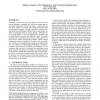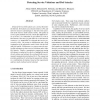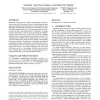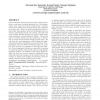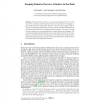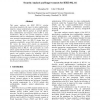SIGCOMM
2003
ACM
14 years 12 months ago
2003
ACM
Launching a denial of service (DoS) attack is trivial, but detection and response is a painfully slow and often a manual process. Automatic classification of attacks as single- o...
NDSS
2003
IEEE
14 years 12 months ago
2003
IEEE
Denial of Service (DoS) attacks are a serious threat for the Internet. DoS attacks can consume memory, CPU, and network resources and damage or shut down the operation of the reso...
CIT
2004
Springer
15 years 3 days ago
2004
Springer
End-to-end congestion control algorithms in TCP are designed for a highly co-operative environment with the assumption that the end hosts voluntarily participate in it and obey th...
MOBICOM
2004
ACM
15 years 4 days ago
2004
ACM
Significant progress has been made towards making ad hoc networks secure and DoS resilient. However, little attention has been focused on quantifying DoS resilience: Do ad hoc ne...
IMC
2004
ACM
15 years 4 days ago
2004
ACM
Current intrusion detection and prevention systems seek to detect a wide class of network intrusions (e.g., DoS attacks, worms, port scans) at network vantage points. Unfortunatel...
WDAG
2005
Springer
15 years 5 days ago
2005
Springer
Abstract. We consider the problem of overcoming (Distributed) Denial of Service (DoS) attacks by realistic adversaries that can eavesdrop on messages, or parts thereof, but with so...
NDSS
2005
IEEE
15 years 8 days ago
2005
IEEE
This paper analyzes the IEEE 802.11i wireless networking standard with respect to data confidentiality, integrity, mutual authentication, and availability. Under our threat model,...
INFOCOM
2005
IEEE
15 years 9 days ago
2005
IEEE
— Traceback mechanisms are a critical part of the defense against IP spoofing and DoS attacks, as well as being of forensic value to law enforcement. Currently proposed IP trace...
ISPEC
2007
Springer
15 years 25 days ago
2007
Springer
Denial of Service (DoS) attacks are a virulent type of attack on the availability of networks’ intended services and resources. Defense against DoS attacks has been built into th...
SRDS
2008
IEEE
15 years 1 months ago
2008
IEEE
We present an empirical study of the resistance of several protocols to denial of service (DoS) attacks on client-server communication. We show that protocols that use authenticat...
